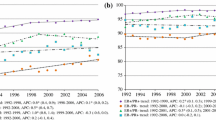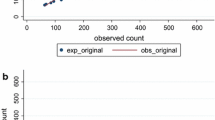Abstract
Purpose. To examine the effect of patient and tumor characteristics on breast cancer survival as recorded in the U.S. National Cancer Institute’s Surveillance, Epidemiology, and End Results (SEER) database from 1973 to 1998.
Methods. A sample of 72,367 female cases from 1973 to 1998 aged 21-- 90 years with invasive ductal breast cancer were examined with Cox proportional hazards regression to determine the effect of age at diagnosis, race, tumor size, tumor grade, disease stage, and year of diagnosis on disease-specific survival.
Results. Larger tumor size and higher tumor grade were found to have large negative effects on survival. Blacks had a 47 % greater risk of death than whites. Year of diagnosis had a positive effect, with a 15 % reduction in risk for each decade in the time period under study. The effects of patient age and disease stage violated the proportional hazards assumption, with distant disease having much poorer short-term survival than one would expect from a proportional hazards model, and younger age groups matching or even falling below the survival rate of the oldest group over time.
Conclusion. Tumor size, grade, race, and year of diagnosis all have significant constant effects on disease-specific survival in breast cancer, while the effects of age at diagnosis and disease stage have significant effects that vary over time.
Similar content being viewed by others
References
Surveillance, Epidemiology, and End Results (SEER) Program (www.seer.cancer.gov) Public-Use Data (1973–1998), National Cancer Institute, DCCPS, Surveillance Research Program, Cancer Statistics Branch, released April 2001, based on the November 2000 submission.
D Cox (1972) ArticleTitleRegression models and life-tables (with discussion) J Royal Stat Soc B 34 187–220
J Chapman M Trudeau K Pritchard C Sawka B Mobbs W Hanna H Kahn D McCready L Lickley (1992) ArticleTitleA comparison of all-subset Cox and accelerated failure time models with Cox step-wise regression for node-positive breast cancer Breast Cancer Res Treat 22 263–272 Occurrence Handle1391992 Occurrence Handle1:STN:280:ByyD3cvotFM%3D
R Vollmer (1996) ArticleTitleMultivariate statistical analysis for anatomic pathology: part II: failure time analysis Am J Clin Pathol 106 522–534 Occurrence Handle8853043 Occurrence Handle1:STN:280:ByiD3crnsVA%3D
D McCready J Chapman W Hanna H Kalm D Murray E Fish M Trudeau I Andrulis H Lickley (2000) ArticleTitleFactors affecting distant disease-free survival for primary invasive breast cancer: use of a log-normal model. Ann Surg Oucol 7 IssueID6 416–426 Occurrence Handle1:STN:280:DC%2BD3M%2FlsFCmtg%3D%3D
S Hilsenbeck P Ravdin C de Moor G Chamness C Osborne G Clark (1998) ArticleTitleTime-dependence of hazard ratios for prognostic factors in primary breast cancer Breast Cancer Res and Treat 52 227–237 Occurrence Handle1:STN:280:DyaK1M7mtl2lug%3D%3D
D Schoenfeld (1980) ArticleTitleChi-squared goodness-of-fit tests for the proportional hazards regression model Biometrika 67 145–153
P Grambsch T Therneau (1994) ArticleTitleProportional hazards tests and diagnostics based on weighted residuals Biometrika 81 515–526
Cox D, Snell E: A general definition of residuals (with discussion), J Royal Stat Soc A 30: 248–275, 1968.
P Wingo L Ries S Parker C Heath (1998) ArticleTitleLong-term cancer patient survival in the United States. Cancer Epidemiol Biomarkers Prev 7 IssueID4 271–282 Occurrence Handle9568781 Occurrence Handle1:STN:280:DyaK1c3islOgsA%3D%3D
R Yancik M Wesley L Ries R Havlik B Edwards J Yates (2001) ArticleTitleEffect of age and comorbidity in postmenopausal breast cancer patients aged 55 years and older. JAMA 285 IssueID7 885–892 Occurrence Handle10.1001/jama.285.7.885 Occurrence Handle1:STN:280:DC%2BD3M7ltF2jug%3D%3D Occurrence Handle11180731
T Therneau P Grambsch (2000) Modeling Survival Data: Extending the Cox Model. Springer-Verlag New York
J Gamel J Meyer E Feuer B Miller (1996) ArticleTitleThe impact of stage and histology on the long-term clinical course of 163,808 patients with breast carcinoma. Cancer 77 IssueID8 1459–1464 Occurrence Handle8608529 Occurrence Handle1:STN:280:BymC1MjksVw%3D
S Gore S Pocock G Kerr (1984) ArticleTitleRegression models and non-proportional hazards in the analysis of breast cancer survival. Appl Statist 33 IssueID2 176–195
G Gasparini S Meli G Panizzoni A Visona P Boracchi P Bevilacqua E Marubini F Pozza (1991) ArticleTitlePeritumoral lymphatic vessel invasion compared with DNA ploidy, proliferative activity, and other pathologic features as prognostic indicators in operable breast cancer Breast, Cancer Res and Treat 20 195–204
L Holmberg A Lindgren T Norden H Adami R Bergstrom (1992) ArticleTitleAge as a determinant of axillary node involvement in invasive breast cancer. Acta Oncol 31 IssueID5 533–538 Occurrence Handle1419099 Occurrence Handle1:STN:280:ByyD2c%2FjsFA%3D
O Aalen (1989) ArticleTitleA linear regression model for the analysis of life times Stat Med 8 907–925 Occurrence Handle2678347 Occurrence Handle1:STN:280:By%2BD3MbgsVE%3D
G Swanson C Lin (1994) ArticleTitleSurvival patterns among younger women with breast cancer: the effects of age, race, stage, and treatment J Nat Cancer Inst Monogr 16 69–77
Y Peng Dear K (2000) ArticleTitleA nonparametric mixture model for cure rate estimation. Biometrics 56 IssueID1 237–243 Occurrence Handle10783801 Occurrence Handle1:STN:280:DC%2BD3c3ks1agsw%3D%3D
C Li K Malone J Daling (2003) ArticleTitleDifferences in breast cancer stage, treatment, and survival by race and ethnicity. Arch Intern Med 163 IssueID1 49–56 Occurrence Handle12523916
C Clarke D West B Edwards L Figgs J Schwartz A Kerner (2003) ArticleTitlewhat: Existing data on breast cancer in African-American women: what we know we need to know Cancer 97 211–221 Occurrence Handle12491484
J Berg R Hutter (1995) ArticleTitleBreast cancer Cancer 75 257–269 Occurrence Handle8001000 Occurrence Handle1:STN:280:ByqD1Mvht1E%3D
S Joslyn (2002) ArticleTitleHormone receptors in breast cancer: racial differences in distribution and survival. Breast Cancer Res Treat 73 IssueID1 45–59 Occurrence Handle12083631 Occurrence Handle1:CAS:528:DC%2BD38XksFehsbw%3D
W Anderson N Chatterjee W Ershler O Brawley (2002) ArticleTitleEstrogen receptor breast cancer phenotypes in the Surveillance, Epidemiology, and End Results database. Breast Cancer Res Treat 76 IssueID1 27–36 Occurrence Handle12408373 Occurrence Handle1:CAS:528:DC%2BD38XntVKjtbo%3D
V Shavers L Harlan J Stevens (2003) ArticleTitleRacial/ethnic variation in clinical presentation, treatment, and survival among breast cancer patients under age 35 Cancer 97 IssueID1 134–147 Occurrence Handle12491515
W McWhorter W Mayer (1987) ArticleTitleBlack/white differences in type of initial breast cancer treatment and implications for survival. Am J Public Health 77 IssueID12 1515–1517 Occurrence Handle2823619 Occurrence Handle1:STN:280:BieD2cjhsFI%3D
C Bradley C Given C Roberts (2002) ArticleTitleRace, socioeconomic status, and breast cancer treatment and survival. J Nat Cancer Inst 94 IssueID7 490–496 Occurrence Handle11929949
N Krieger (2002) ArticleTitleIs breast cancer a disease of affluence, poverty, or both? The case of African American women. Am J Public Health 92 IssueID4 611–613 Occurrence Handle10.2105/AJPH.92.4.611 Occurrence Handle11919060
W Black H Welch (1997) ArticleTitleScreening for disease Am J Radiology 168 3–11 Occurrence Handle1:STN:280:ByiC3s7isFw%3D
L Rutqvist A Wallgren (1985) ArticleTitleLong-term survival of 458 young breast cancer patients Cancer 55 658–665 Occurrence Handle3965114 Occurrence Handle1:STN:280:BiqD2svgs1U%3D
Author information
Authors and Affiliations
Corresponding author
Rights and permissions
About this article
Cite this article
Rosenberg, J., Chia, Y.L. & Plevritis, S. The effect of age, race, tumor size, tumor grade, and disease stage on invasive ductal breast cancer survival in the U.S. SEER database. Breast Cancer Res Treat 89, 47–54 (2005). https://doi.org/10.1007/s10549-004-1470-1
Issue Date:
DOI: https://doi.org/10.1007/s10549-004-1470-1




